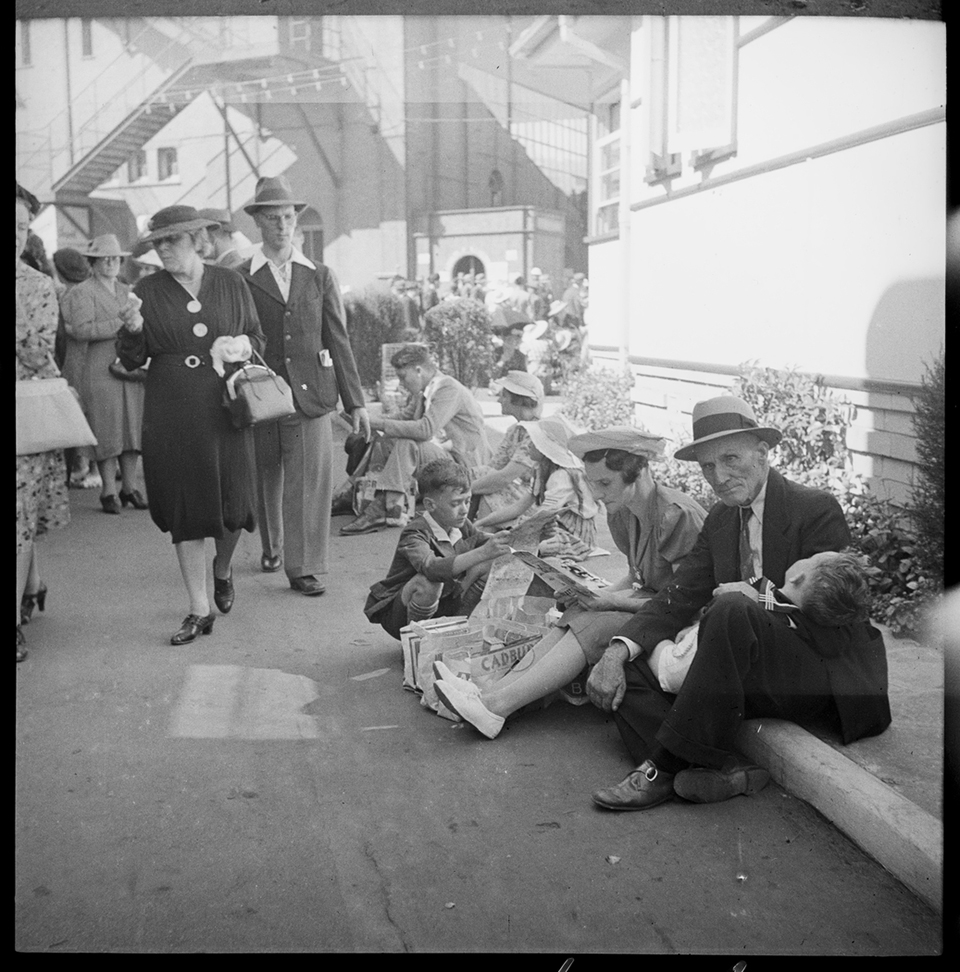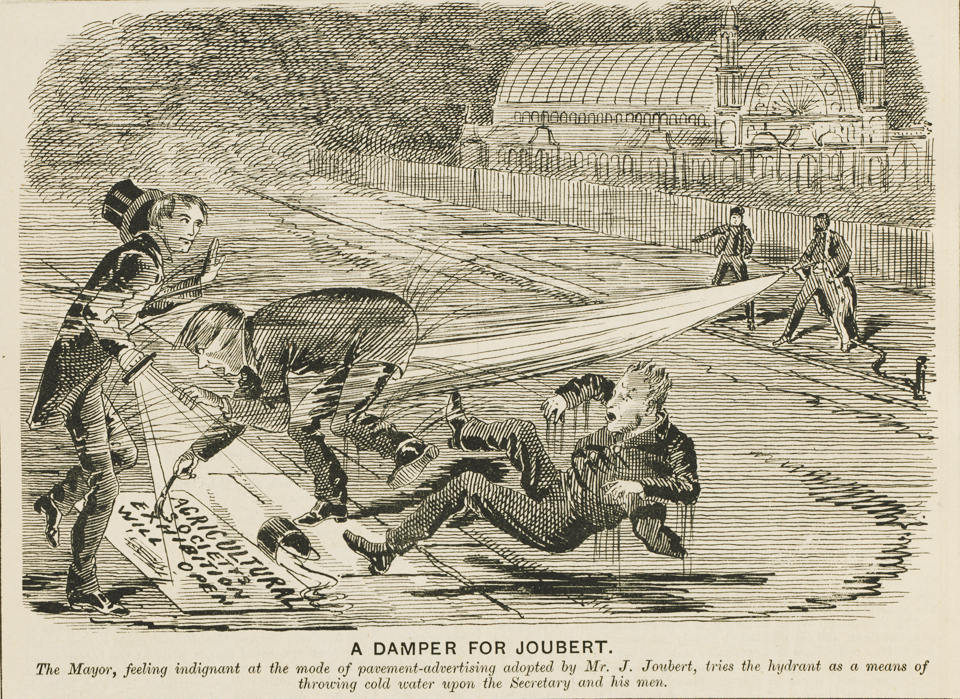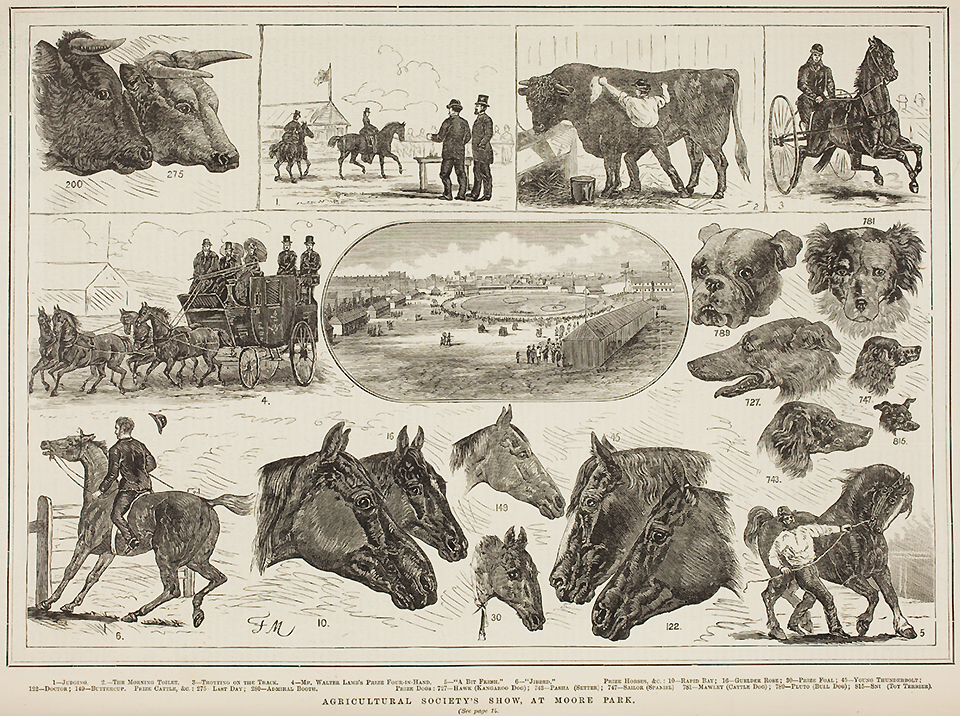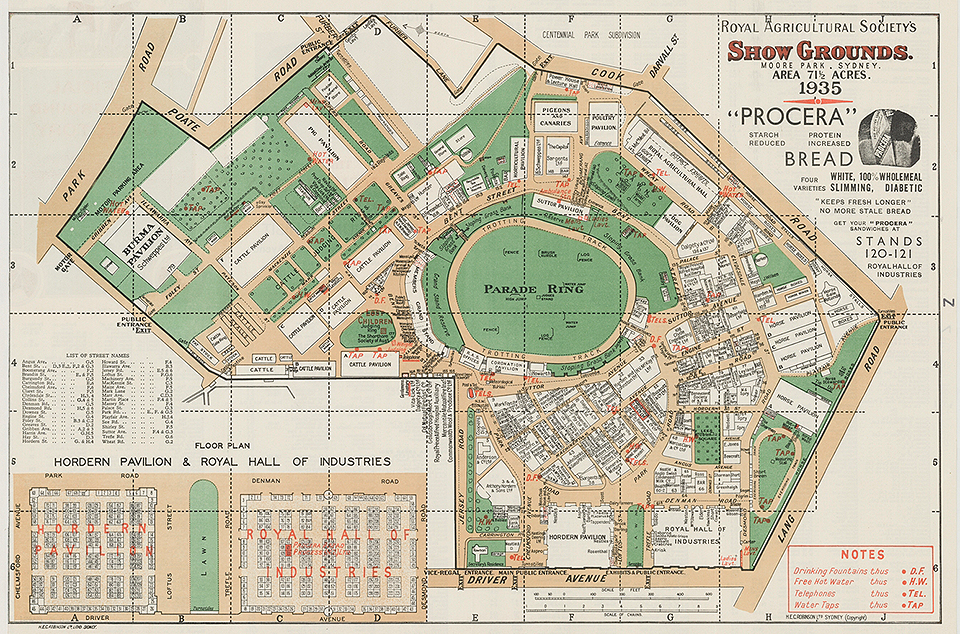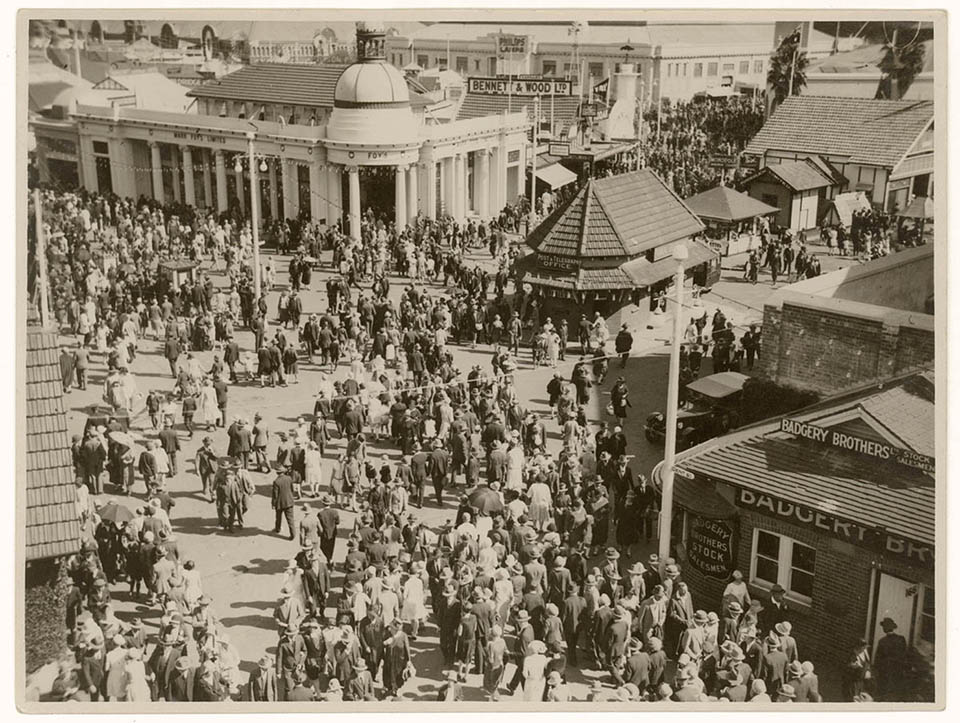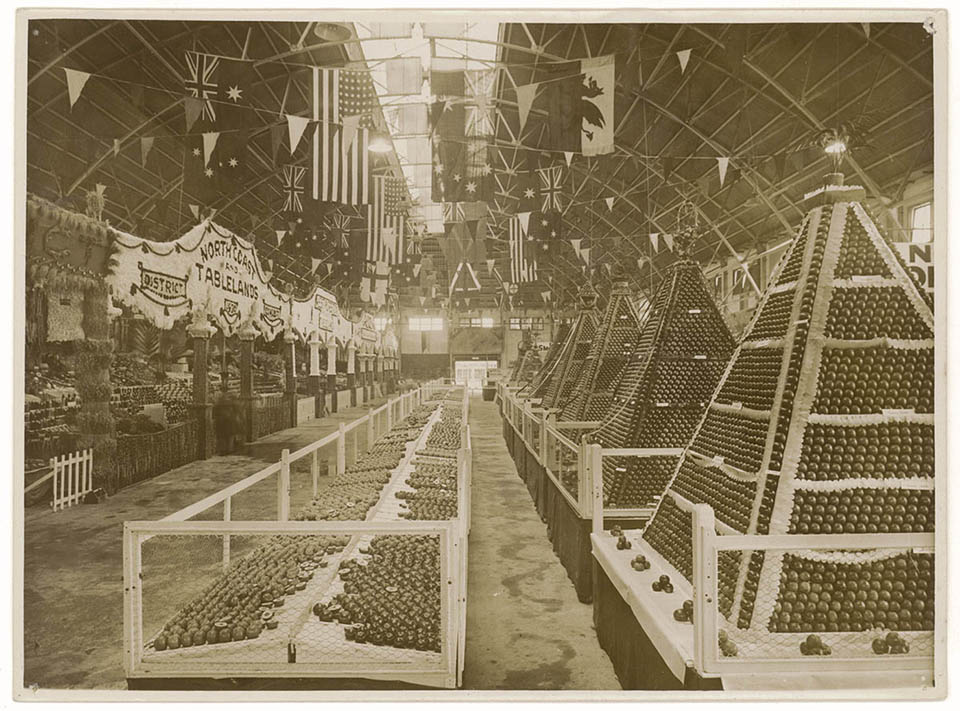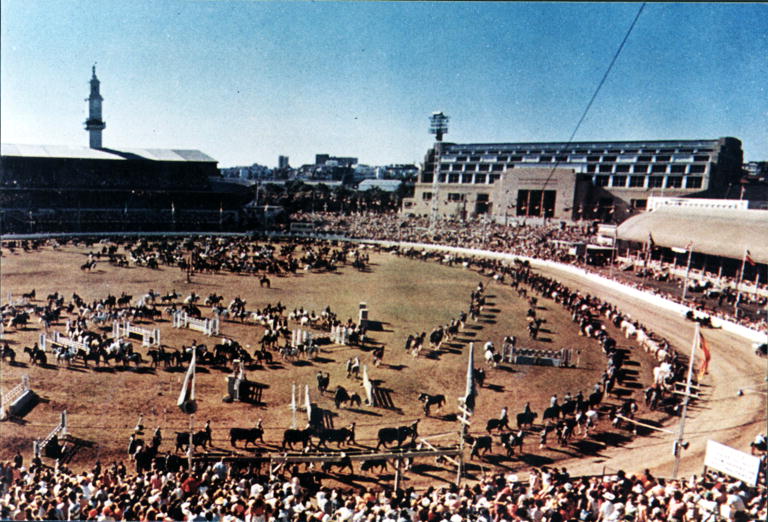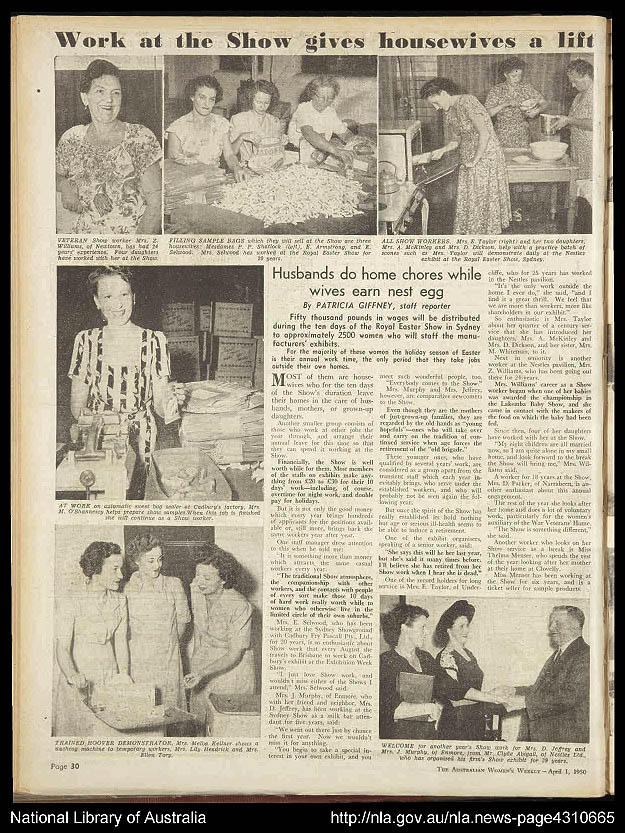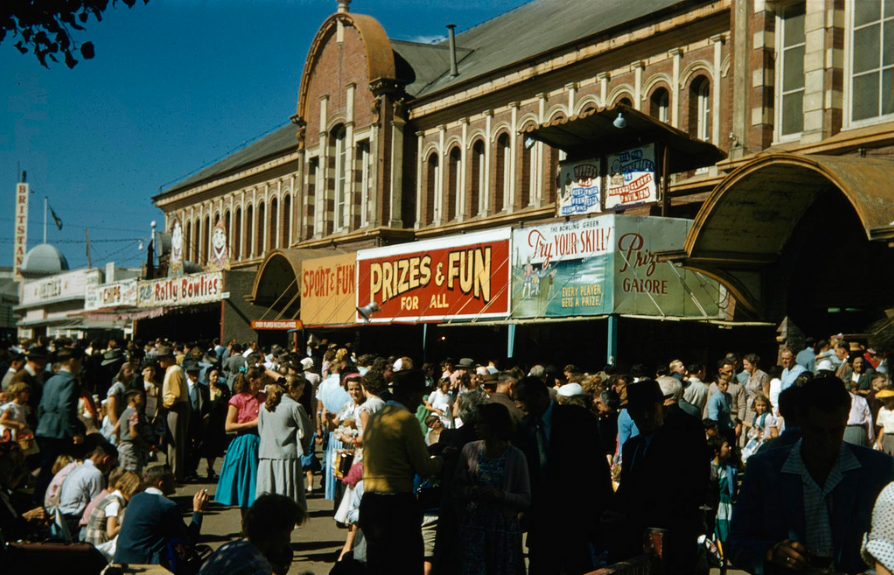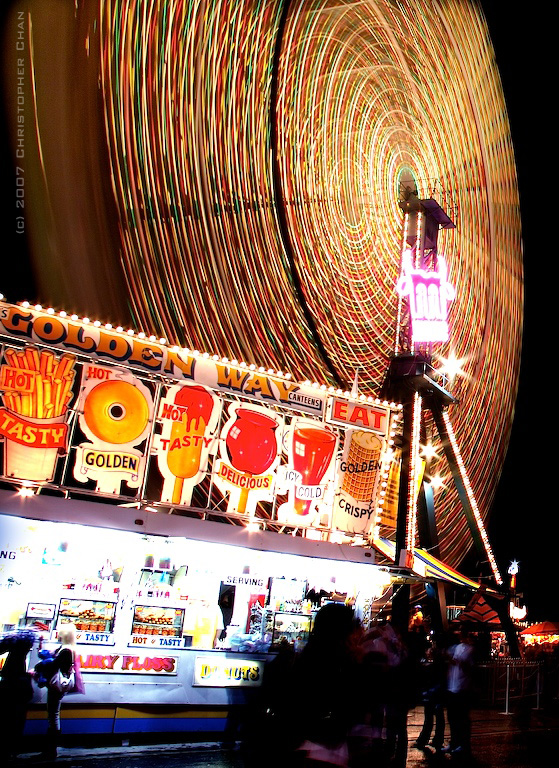The Dictionary of Sydney was archived in 2021.
Royal Easter Show
Citation
Persistent URL for this entry
To cite this entry in text
To cite this entry in a Wikipedia footnote citation
To cite this entry as a Wikipedia External link
Royal Easter Show
[media]Sydney's Royal Easter Show is the nation's largest annual event, currently attracting more than 900,000 visitors to its site at Homebush Bay. Historically a showcase for New South Wales's primary and secondary industries, and for the promotion of agricultural education and improvement, the Show places greater emphasis today on commercial and entertainment offerings. For generations, the Show has brought 'the country to the city', and it continues to be important, especially for children, in Sydney's cultural life.
Origins
[media]In 1822, the Agricultural Society of New South Wales was established by the leading 'gentlemen' of the colony, with the aim of encouraging profitable cultivation techniques and livestock production suited to the local environmental and climatic conditions. [1] A key activity of the new Society was the organisation of an annual competitive display of animals and produce, thus providing agricultural education to the public and enabling its members to meet and conduct business. The first show was held at Parramatta in 1823 and included prizes for high performing servants as well as the 'best' rams, cheeses, and beer. [2] However, drought and an economic downturn forced the Society to disband in 1836.
[media]In 1857, the Cumberland Agricultural Society was established. In 1859, it was renamed the Agricultural Society of New South Wales (ASNSW), now representing the farming interests of the whole colony. Regular exhibitions and ploughing matches were organised at the Parramatta Domain. In 1869, following an expansion of its membership, the Society relocated this annual event to Prince Alfred Park in Sydney. As the Metropolitan Inter-Colonial Exhibition, it was now held over four days, attracting more than 37,000 people. The displays were extensive, including machinery, fine arts, manufactured goods and items sent from the other Australian colonies and from overseas. They demonstrated the colonial triumph of 'civilisation' over the natural world. [3] To accommodate the growing demands for exhibition space, the Prince Alfred Park Exhibition Building was built.
[media]By 1880 the Society could no longer afford the high rent at Prince Alfred Park and was looking for an affordable site. It found 40 acres (16 hectares) of rough scrubby land at Sydney Common, available for lease at £10 per year. Funds were raised from the colonial government and the general public, to transform this site into an operable showground. In 1882, the first Show opened at Moore Park, and despite a delay due to exceptionally wet weather, there were record attendances. Exotic animals, such as llamas, ostriches and alpacas, were exhibited alongside more ordinary livestock, and bicycle racing was introduced as a ring spectacle. [4]
[media]The ASNSW was dogged by financial difficulties over the next two decades, and was engaged in a legal challenge about its right to lease land at Moore Park. But there was increasing public support for the continuation of the Show. In 1891 Queen Victoria granted permission for the 'Royal' prefix to be added to the Society's name, so that it became the Royal Agricultural Society of New South Wales (RASNSW). By 1901, the Royal Easter Show was turning a healthy profit, and the Society was eventually granted the title of the land at Moore Park it had previously leased.
The Moore Park Showground
[media]The move to Moore Park enabled the development of a diverse range of educational, entertainment and commercial activities at the Royal Easter Show. The introduction of electrical lighting in 1894, with full electrification in 1916, expanded its operating hours and meant that elaborate entertainments could be held in the evening.
[mediaBuildings ]were gradually constructed around the central arena or parade ring, which was at the heart of the Moore Park Showgrounds. These were connected by streets, which circled and led away from the arena as well as forming a rectangular grid around the livestock pavilions. The buildings included grandstands, stables, and halls for exhibitions and commercial activities. Many are of individual architectural significance, including the Royal Hall of Industries, dating from 1913; the Members' Grandstand, completed in 1924; and the Hordern Pavilion, built in free classical style in 1924 and remodelled as an entertainment venue in 1972. The Art Deco Manufacturers Hall and Commemorative Pavilion was built to mark the 150th commemoration of the settlement of New South Wales, and to accommodate a major exhibition of Australian goods held in conjunction with the 1938 Royal Easter Show.
[media]The Moore Park Showgrounds were not open just during the Royal Easter Show, but also used for a variety of public gatherings, exhibitions and entertainments throughout the year. These included trade fairs, political or religious meetings and conferences. During the 1919 flu epidemic, the exhibition halls were converted to a temporary hospital and morgue. In World War II, the grounds were requisitioned for military use and training. The national Royal Tour of Queen Elizabeth II in 1954 was launched at the showgrounds, when the Queen circled the grand arena in a car before a crowd of thousands, including many schoolchildren, sitting in the grandstands. [5] Exhibition pavilions were regularly transformed into venues for ice-skating, roller-skating, international boxing matches, dances, balls and live performances.
The Royal Easter Show at Moore Park: Exhibition, Education and Wonder
[media]Attendances at the Royal Easter Show grew steadily during the first decades of the twentieth century. By 1938, when the Show program celebrated the sesquicentenary of New South Wales, the event ran for 13 days. A highlight was a spectacular display representing all primary and secondary industries, with 12,000 schoolchildren in colourful uniforms representing a 'Wheel of Progress'. [6]
[media]In the post-World War II decades, the Royal Easter Show continued to draw larger numbers, including thousands of exhibitors from rural New South Wales. From the late nineteenth century, 'Showtime' in Sydney encompassed a multitude of social activities – such as the Town & Country Ball – that enabled country families to enjoy the social, shopping and business attractions of the city.
The Show offered unique opportunities for social mixing, not just by 'bringing the country to the city' but across social classes. This is the theme of Miles Franklin's novella Sydney Royal: divertisement (1947), a rollicking tribute to the human dramas of the Show as expressed through a cast of strong-minded children and the luckless adults they drag into their adventures. Franklin's characters are satirical representations of Australian society, from the vice-regal family, the sideshow operators, the working class from Woolloomooloo, and the country 'woop' from Woop Woop – but all are swept up together at the Royal Easter Show. [7]
The exhibition and demonstrations of farming techniques became more diverse, and during the twentieth century there was a strong focus on agricultural education and government initiatives in the rural sector. The Royal Easter Show has played an important part in the development of stock breeding in Australia through its emphasis on improved breeding and awarding of competitive prizes. Competitive classes for wool, wine and dairy products remain important. The District Exhibits have been a showcase for the fruit, vegetables, grains, preserves and other agricultural produce of the regions of New South Wales. These complex displays, which can involve more than 2,000 items, are assessed according to a point system.
[media]Competitive categories of crafts, arts and cookery have traditionally been seen as 'women's' exhibits, although more men are now entering their jams, cakes and needlework. Paintings, photography and sculpture are among the fine arts that have long been exhibited at the Show. Wood-chopping is a very different demonstration of skill, and one that grew out of the informal competitions held by Australian timber workers. The first formal woodchop event was held at the Show in 1899. By 1938 a wood-chopping ring was built at Moore Park and the equipment used was standardised.
[media]In the arena at the centre of the Moore Park Showground, livestock were judged, and equestrian events and special attractions held. In 1907 the Grand Parade was introduced, becoming an increasingly elaborate display of almost 800 prize-winning goats, cattle and horses. From the 1930s, rodeo activities became a regular feature of the ring. Over time, however, many of the performances held in the central arena became less directly related to agricultural pursuits and were (and are) unashamedly entertainment.
[media]The Royal Easter Show was also the site of commercial exchanges and the celebration of Australian inventions and products. Demonstrations and sale of agricultural innovations and machinery were important up to the 1960s. From the late nineteenth century, free samples of products and foodstuffs were handed out, and these were to evolve into 'sample bags'. By the mid-twentieth century, specialised showbags were available for purchase and have remained an important aspect of the Show experience, especially for children.
[media]While entertainment was always a component of early colonial shows, the move to the Moore Park Showground meant an expansion of amusement rides and carnival attractions. The Showman's Guild was formed in 1909 to represent the interests of the 'showies', and by the 1920s a distinct Sideshow Alley had formed. As well as games and rides, at its heyday in the mid-twentieth century Sideshow Alley included waxworks, illusion shows, Sharman's boxing troupe, animal acts – from performing fleas to leaping lions, and a number of human freak displays. In 1948 the RASNSW, succumbing to changing tastes, announced a 'clean up' of the sideshows, reducing the area available and banning performing animals and human freaks. [8]
[media]The Royal Easter Show has continued to be the premier event in New South Wales for the promotion of agricultural produce and activities. Since the 1960s, the RASNSW and other agricultural societies have been active in fostering skills for young rural dwellers. [9] More recently, rural communities have faced economic, climatic and social challenges, and there has been a demographic shift in the population of non-metropolitan Australia. In bridging the gap between rural and metropolitan communities, exhibits at the Royal Easter Show have provided insight into the scale of change in rural New South Wales, from new environmentally sustainable farming techniques, gourmet and organic produce and the commodification of a 'country lifestyle'.
The Move to Sydney Olympic Park, Homebush Bay
[media]By the 1990s, the facilities at the Moore Park Showground required a major upgrade. The RASNSW decided that it would be preferable to relocate its offices and showground to Sydney Olympic Park at Homebush Bay, and in 1994 work commenced on the new site. In 1998, the first Royal Easter Show was held at Homebush Bay. Fox Movie Studios moved into the Moore Park Showground, establishing a film production and entertainment complex. The Royal Agricultural Society Showground Conservation Area at Moore Park is now listed on the Register of the National Estate in recognition of its significant architectural and historical heritage.
At Homebush Bay, the RASNSW has access to extensive purpose-built display facilities, including 20 pavilions, with a rail link and 10,000 car spaces for visitors. This complex of buildings includes the massive dome and hall of the Exhibition Building, the largest timber span structure in Australia. Every year over 1.5 million people visit the Sydney Showground at Homebush Bay to attend conferences, musical activities and trade displays. The RASNSW remains a vibrant active organisation, with more than 13,000 members. Its Royal Easter Show has flourished in its new venue, and remains an important event for the celebration of the traditions and innovations in Australian culture.
References
Kay Anderson, 'White Natures: Sydney's Royal Agricultural Show in Post-Humanist Perspective', Transactions: Institute of British Geographers, vol 38, 2003, pp 422–41
Richard Broome with Alick Jackomos, Sideshow Alley, Allen & Unwin, Sydney, 1998
Anne Cooke, Going to the Show?: Images and Memories of Sydney's Royal Easter Show. Historic Houses Trust of New South Wales & Royal Agricultural Society of New South Wales, Sydney, 1996
Kate Darian-Smith and Sara Wills, Agricultural Shows in Australia: A Survey, Australian Centre, University of Melbourne, 1999
Kate Darian-Smith and Sara Wills, 'From Queen of Agriculture to Miss Showgirl: Embodying Rurality in Twentieth-Century Australia', Journal of Australian Studies, no 71, 2001, pp 17–31
Brian Fletcher, The Grand Parade: A History of the Royal Agricultural Society of New South Wales, The Royal Agricultural Society of New South Wales, Paddington, New South Wales, 1988
Royal Agricultural Society of New South Wales website, http://www.rasnsw.com.au, viewed 22 April 2010
Notes
[1] The Van Diemen's Land Agricultural Society had been established on 1 January 1822, and may have spurred the formation of the Agricultural Society of New South Wales. Similar societies were formed in Perth in 1829, Adelaide in 1839 and Port Phillip in 1840
[2] Brian Fletcher, The Grand Parade: A History of the Royal Agricultural Society of New South Wales, The Royal Agricultural Society of New South Wales, Paddington, New South Wales, 1988, p 27–32
[3] See Kay Anderson, 'White Natures: Sydney's Royal Agricultural Show in Post- Humanist Perspective', Transactions: Institute of British Geographers, vol 38, 2003: 422–41
[4] Anne Cooke, Going to the Show?: Images and Memories of Sydney's Royal Easter Show. Historic Houses Trust of New South Wales & Royal Agricultural Society of New South Wales, Sydney, 1996, p 22
[5] Anne Cooke, Going to the Show?: Images and Memories of Sydney's Royal Easter Show. Historic Houses Trust of New South Wales & Royal Agricultural Society of New South Wales, Sydney, 1996, p 77
[6] Brian Fletcher, The Grand Parade: A History of the Royal Agricultural Society of New South Wales, The Royal Agricultural Society of New South Wales, Paddington, New South Wales, 1988 p 205–6
[7] Miles Franklin, Sydney Royal: divertisement, Shakespeare Head Press, London and Sydney, 1947 Illustrator: Nan Knowles. Also includes two poems by Miles Franklin, 'Ballard of Sydney Royal' and 'The Fortune Teller's Song'
[8] Richard Broome with Alick Jackomos, Sideshow Alley, Allen & Unwin, Sydney, 1998, p 193
[9] For instance, in 1962, the first Miss Showgirl competition was held at the Sydney's Royal Easter Show enabling the winners of regional competitions to compete for the statewide title. See Kate Darian-Smith and Sara Wills, 'From Queen of Agriculture to Miss Showgirl: Embodying Rurality in Twentieth-Century Australia', Journal of Australian Studies, no 71, 2001, 17–31
.


